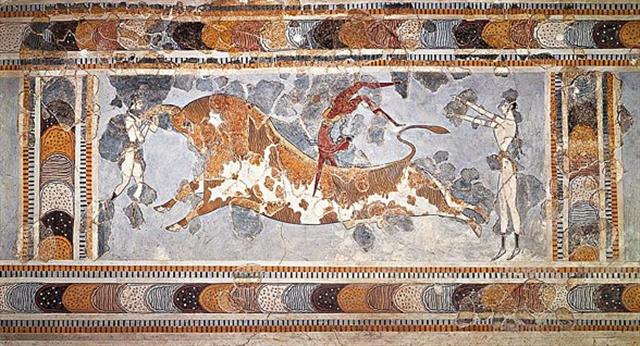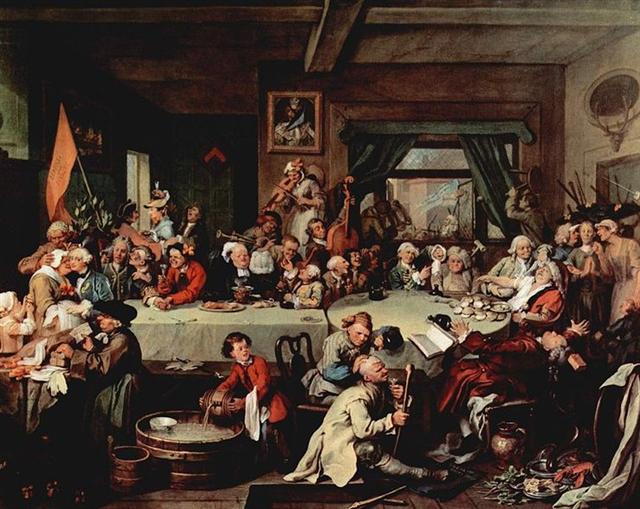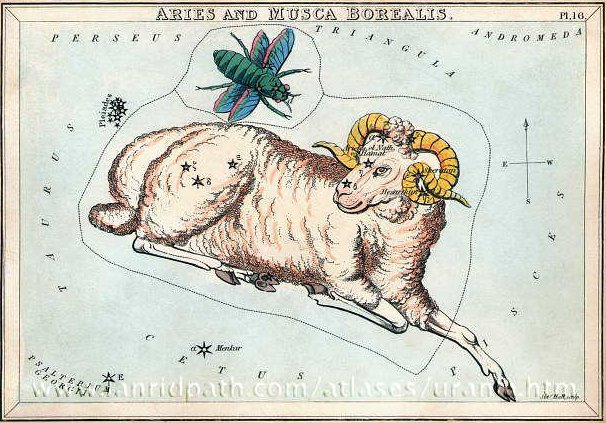20. The glyph type hua poporo has in its center a kind of rakau (tree), and from there off-spring (hua) was generated:
By adding 64 precessional days to October 9 the position of this date among the stars at the time of Hyadum II was reached. The seasons north of the equator and at the time of Hyadum II - as documented by the constellations - were evidently adopted both on Samoa and on Tahiti:
Spica (Ear of Wheat) rose with the Sun in October 9 (once upon a time in AUGUST 6) and we can assume the creator of the C text illustrated the beginning of a rainy seson early on side a of his tablet. With 'tears' the family of the buried god of war Ku watered the top of his head until a small green shoot appeared. Early I deduced Ca4-1 was a picture of the main stars in Auriga, with the 'nut' at bottom corresponding to Elnath (the Butting One, β Tauri):
The Greek letter γ was used in Auriga for the same star which in Taurus was β. The hatch-marked 'stone' at bottom in Ca4-1 was like the head of the Old One from which a new Prince (Ku, the Leading One) would grow. Elnath (*80) - Hamal (*30) = 50 = 364 - 314.
As an argument for this interpretation I used rakau glyphs and first of all the young one ('prince', Babylonian Ku) in Ga4-13 (where 413 = 14 * 29½): ... It [Hamal] also was Anuv, and had its constellation's titles I-ku and I-ku-u, - by abbreviation Ku, - the Prince, or the Leading One, the Ram that led the heavenly flock, some of íts titles at a different date being applied to Capella of Auriga ...
A number of 'coincidences' support my ideas. For instance should be mentioned the date chosen by the Pope Gregory XIII for launching his newborn calendar: ... The Julian calendar day Thursday, 4 October 1582 was followed by the first day of the Gregorian calendar, Friday, 15 October 1582 (the cycle of weekdays was not affected) ...
Then we should contemplate the Julian date for the previous day, viz. 4 October, which resembles OCTOBER 4 at Ca4-2. There were 10 days 'missing' where the Julian calendar was changed into the Gregorian calendar. ... The reform was adopted initially by the Catholic countries of Europe. Protestants and Eastern Orthodox countries continued to use the traditional Julian calendar and adopted the Gregorian reform after a time, for the sake of convenience in international trade. The last European country to adopt the reform was Greece, as late as 1923 ... Britain and the British Empire (including the eastern part of what is now the United States) adopted the Gregorian calendar in 1752, by which time it was necessary to correct by 11 days. Wednesday, 2 September 1752, was followed by Thursday, 14 September 1752. Claims that rioters demanded 'Give us our eleven days' grew out of a misinterpretation of a painting by William Hogarth.
And according to Manuscript E the double-canoe of Hotu A Matua arrived to Easter Island in 15 October (possibly corresponding to December 18 at heliacal Menkalinan and day 4 * 88 = 352): ... The canoes of Ava Rei Pua and of Hotu were seen near the (off-shore) islets. On the fifteenth day of the month of October (tangaroa uri) the canoe of Hotu and the canoe of Ava Rei Pua landed. On the fifteenth day of the month of October (tangaroa uri), Nonoma left the house during the night to urinate outside. At this point Ira called out to Nonoma, 'Look at the canoe!' Nonoma ran, he quickly went to Te Hikinga Heru (a ravine in the side of the crater Rano Kau) and looked around. There he saw the double canoe way out near the (offshore) islets, and the two (hulls of the canoe) were lashed together. He ran and returned to the front of the house. He arrived and called into the house: 'Hey you! This canoe has arrived during the night without our noticing it!' Ira asked Nonoma, 'Where is the canoe, which you say is lying out there (in the water)?' Nonoma's voice came back: 'It is out there (in the water) close to the (offshore) islets! There it lies, and the two (hulls) are lashed together.' The four of them (corrected for 'the six of them') went out and picked up leaves (on branches) to give signals. They picked them up, went and arrived at Te Hikinga and saw the canoe. Raparenga got up, picked up the leaves, took them in his hands, and waved, waved, waved, waved ... The stars stood still and it was the Sun who caused problems because his cardinal points moved due to the precession. OCTOBER 15 was always day 288 (= 2 * 144) and OCTOBER 4 always day 277 (= 6 * 29½ + 100). There were indeed 10 (respectively 11) days missing. As to the G text I have guessed heliacal Antares (Rehua) was arriving in Tagaroa Uri 15 by counting from 0h at the time of Bharani, i.e. 41 precessional days earlier than the time of rongorongo:
In the Hindu system the place for birth was at Bharani (41 Arietis):
... From a religious point of view, the high regard for flies, whose increase or reduction causes a similar increase or reduction in the size of the human population, is interesting, even more so because swarms of flies are often a real nuisance on Easter Island, something most visitors have commented on in vivid language. The explanation seems to be that there is a parallel relationship between flies and human souls, in this case, the souls of the unborn. There is a widespread belief throughout Polynesia that insects are the embodiment of numinous beings, such as gods or the spirits of the dead, and this concept extends into Southeast Asia, where insects are seen as the embodiment of the soul ... |
|||||||||||||||||||||||||||||||||||||||||||||||||||||||||||||||||||||||||||||||||||||||||||||||||||||||||||||||||||||||||||||||||||||||||||||||||||||||||||||||||||||||||||||||||||||||||||||||||||||||||||||||||||||||||||||||||||||||||||||||||||



















